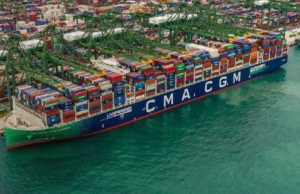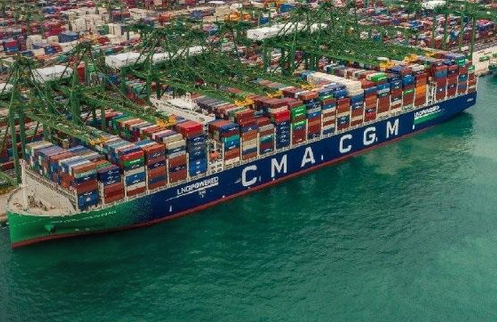
The CMA CGM Jacques Saade, the first liquefied natural gas (LNG)-powered container ship with a capacity of 23,000 containers, has set a world record for the number of full containers loaded on a single vessel.
On her departure from Singapore last week, the group’s new flagship was carrying a record 20,723 full containers, CMA CGM said in an official October 18 statement.
After joining the group’s fleet on September 22, the mega container ship is now on her maiden voyage on the French Asia Line (FAL 1) connecting Asia with Europe. This line provides a weekly service comprising 13 calls over the course of 84 days.
“To carry so many containers we have to be able to stack them 10 or 11 high on the deck, giving rise to strict constraints linked to the vessel’s structure and, crucially, how containers are stowed,” explained Marc Olazabal, operations manager of E&W Lines, who directs the group’s operations.
“The vessel is so well designed that we were able to pile containers of over 10 tons in a 10-high stack, which is outstanding.”
To complete the loading process, all the teams had to work together seamlessly and position the containers at the yard in reverse loading order ahead of the ship’s arrival.
It also involved substantial cooperation between the port teams and the ship planner to decide on the crane split—the number of cranes that will work on the vessel during the call.
“During the call in Singapore, the 9 cranes in position completed around 4,000 (loading and unloading) movements. All the cranes had to have the same number of movements in order for the operations to be completed at the same time, and to avoid any reduction in our productivity,” Olazabal continued.
The CMA CGM Jacques Saadé stands out from other ultra-large container ships in that it can carry one extra row of containers.
“It may not seem like very much, but some ports are not yet equipped with cranes that can reach the final row. That means the ship planner needs to take this into account in the loading plan. It requires intricate planning down to the finest details,” said Olazabal.
Photo from CMA CGM





